Planet Obliquity
Obliquity is the angle of the planet’s axis of rotation (red line) from the perpendicular to the plane of the orbit (green line) – see the animation.
Due to the changing positions of the planets, the gravitational pull between the moving masses is continually changing. These tugs in different directions change the planets’ orbits. As obliquity changes, the maximum amount of illumination in the northern and southern hemispheres changes.
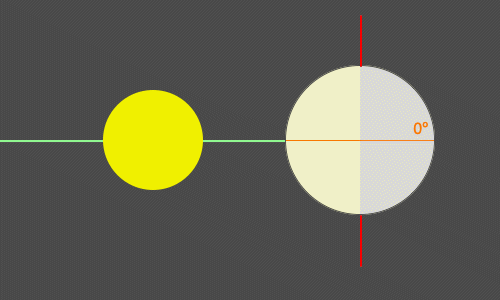
The animation shows that as obliquity increases, the annual range of the distribution of sunlight between the northern and southern hemispheres increases. The red line is the axis of rotation, and the cyan line is perpendicular to the plane of orbit. The orange line is the Equator.
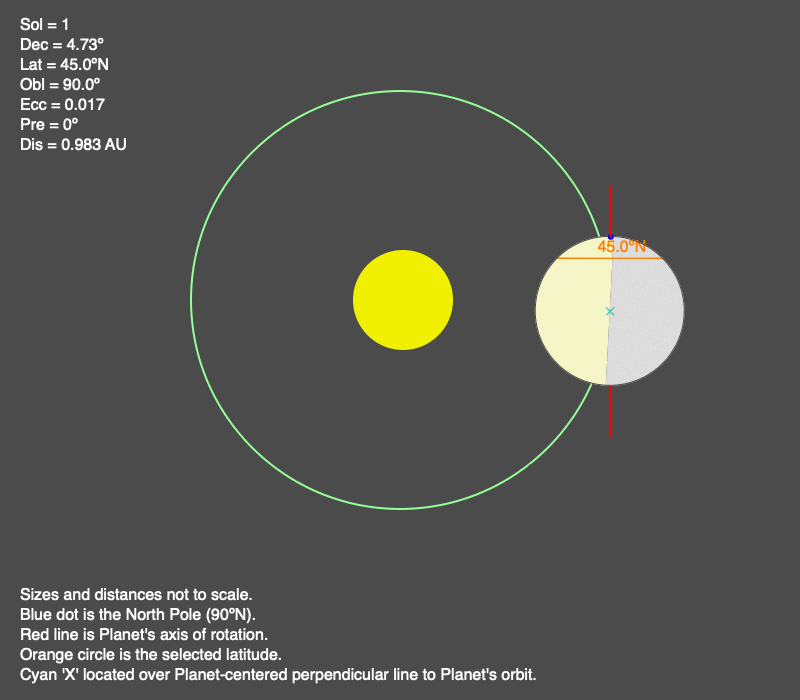
Because the rotating planet acts as a gyroscope, the orientation of the axis of rotation (red line) remains fixed in space as it orbits its star. The orange line is 45ºN latitude.
Use the animations that follow to explore how changing obliquity affects the planet’s radiation budget, which, in turn, affects its diurnal heating, the intensity of seasons, and the location of climate regimes.
Changing Obliquity and Planet Illumination on the Summer Solstice
Below are animations made at the Northern Hemisphere summer solstice, so the most extreme amount of sunlight illuminating that hemisphere. For more information about solstices and equinoxes, see Obliquity and Earth Illumination. The obliquity changes from 0º to 90º in 5-degree increments. Examine how the northern hemisphere illumination changes as the obliquity increases. Three latitudes were selected to illustrate the solar angle at local noon during each solstice: 0º, 45ºN, and 90ºN. The green line is the horizon, and the magenta line is the zenith at the given latitude (see Earth’s Coordinate System for details).
Equator (0º)
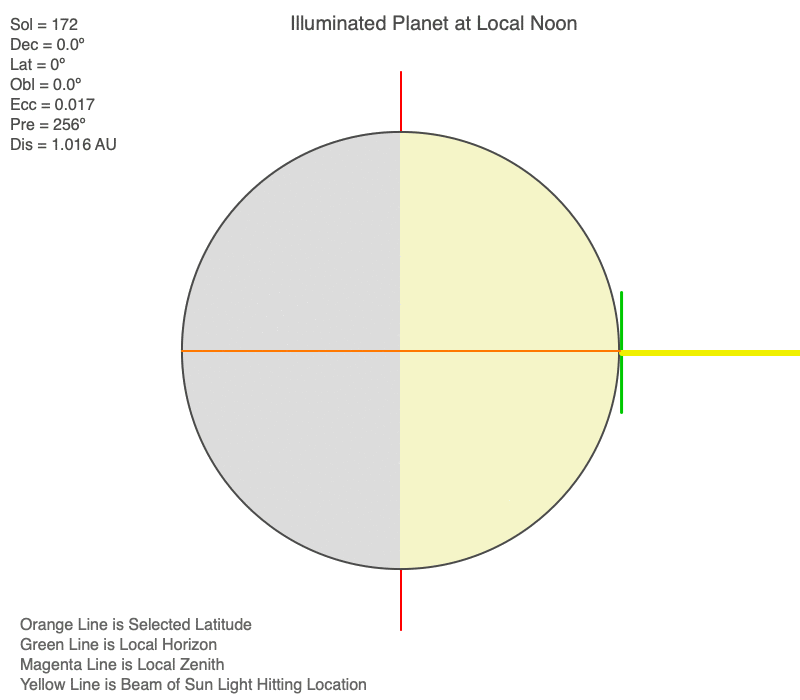
When the obliquity is 0º, the Sun is directly overhead the equator at local noon during the solstice. As the obliquity increases the local noon sun angle decreases. When the obliquity is 90º, the Sun is on the horizon at local noon during the solstice. The orange line is the Equator.
45ºN

When the obliquity is 0º, the Sun is 45º above the horizon at local noon during the solstice. As the obliquity increases to 45º, the local noon sun angle increases. At larger obliquities, the local noon sun angle decreases. When the obliquity is 90º, the Sun is 45º above the horizon at local noon. The orange line is 45ºN latitude.
North Pole (90ºN)
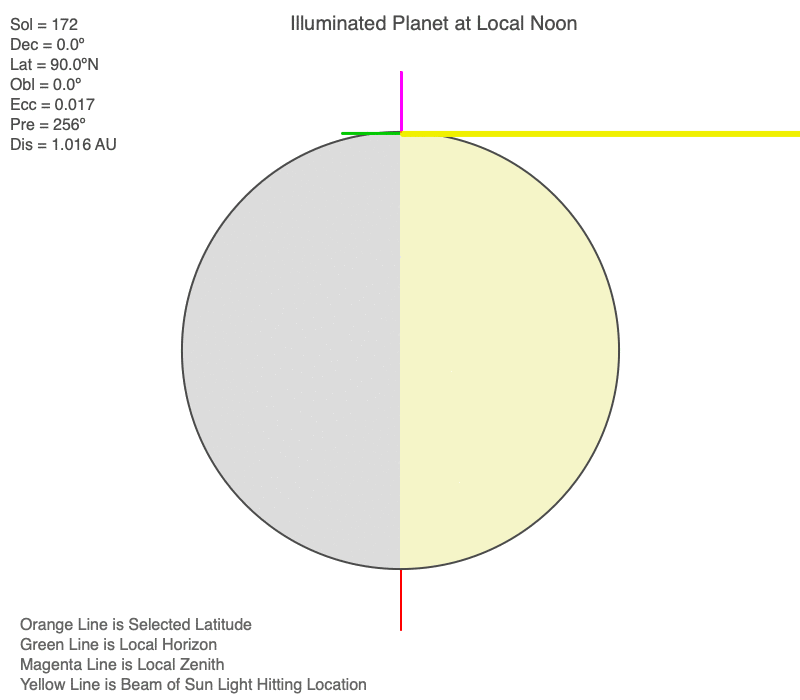
When the obliquity is 0º, the Sun remains on the horizon all day at the North Pole. As the obliquity increases the local noon sun angle increases. When the obliquity is 90º, the Sun is directly overhead all day during the solstice. The horizon and zenith are located at the North Pole.
Changing Obliquity and Declination Circles on the Summer Solstice
Below are animations of north-south oriented declination circles for three latitudes during the northern hemisphere’s summer solstice at obliquity increases from 0º to 90º in 5-degree increments. See Declination, Latitude, and Illumination for an introduction to declination circles.
The green line is the horizon, and the gray line marked by ‘Z’ is the zenith at the given latitude.
Equator (0º)
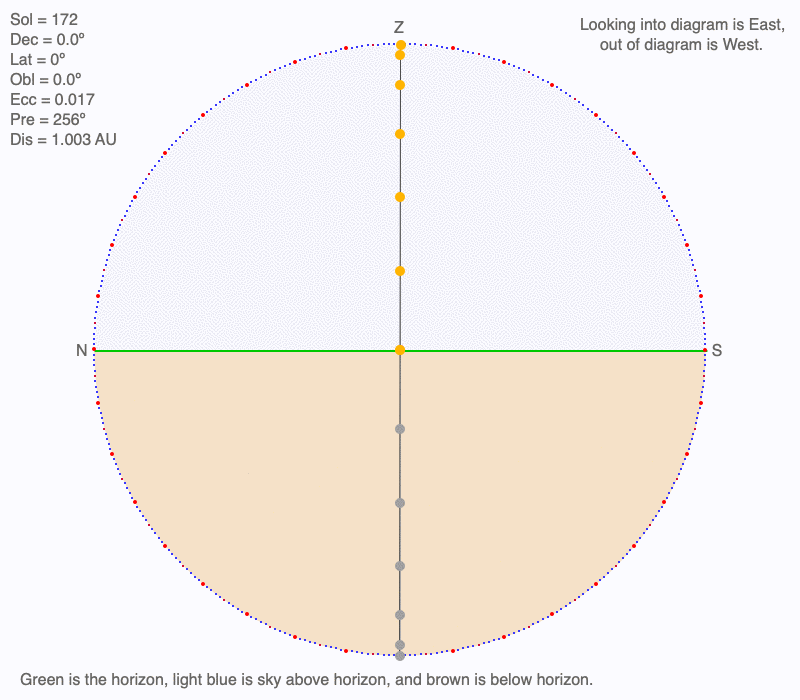
Animation of the equator’s declination circle during the northern hemisphere’s summer solstice changing as the planet’s obliquity increases from 0º to 90º. The star’s motion will always be perpendicular to the horizon at the Equator, but as obliquity increases, the path of the sun shifts northward and gets lower in the sky at local noon. When the obliquity is 90º, the star stays in the horizon exactly north for 24 hours.
45ºN
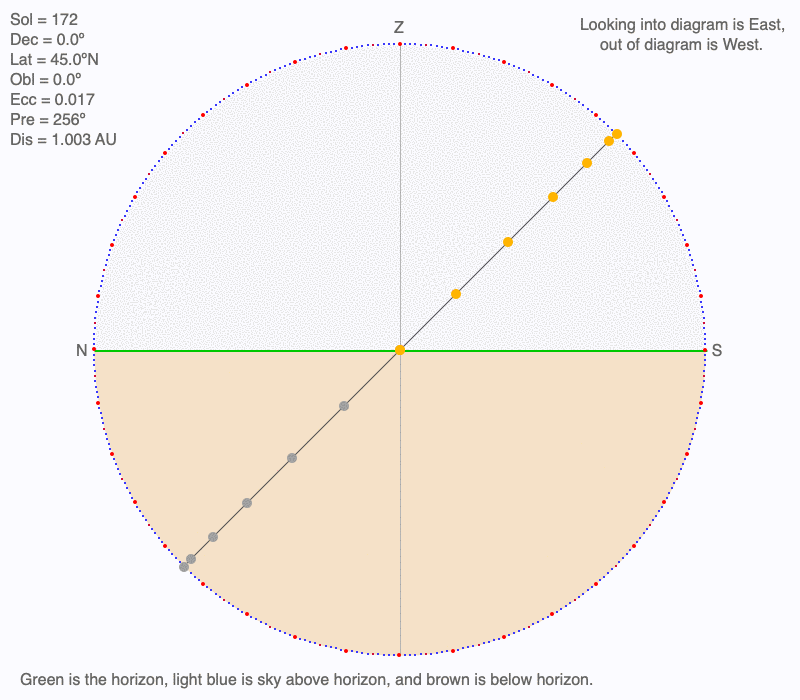
Animation of how the declination circle at 45ºN during the northern hemisphere’s summer solstice changing as the planet’s obliquity increases from 0º to 90º. The star’s motion will always be 45º to the horizon at this latitude. As obliquity increases to 45º, local noon sun angle increases, and at 45º the sun is directly overhead at local noon. As the obliquity changes, the number of hours of daylight increases. When the obliquity is greater than or equal to 45º, the star will be above the horizon throughout the day. At 90º obliquity, the sun remains 45º above the horizon exactly north for 24 hours.
North Pole (90ºN)
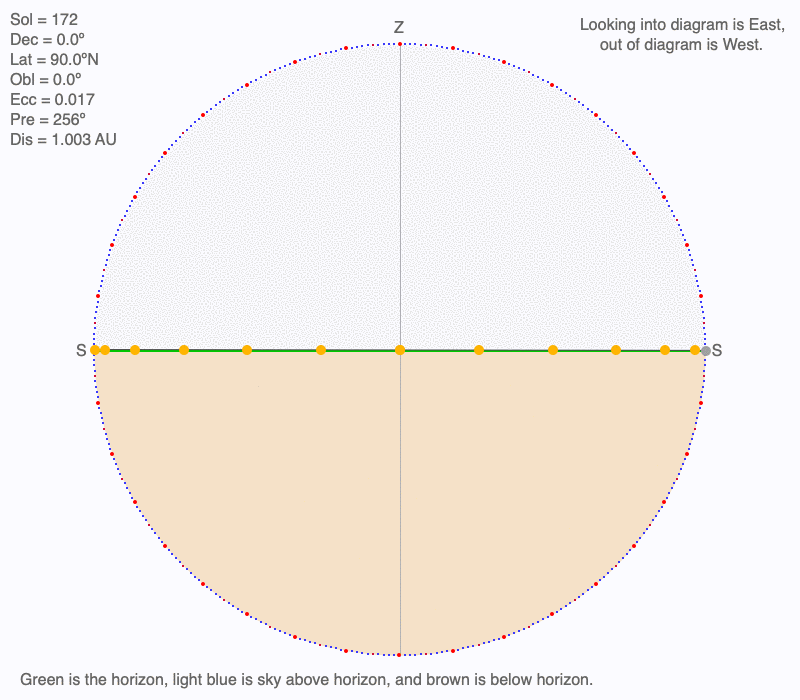
Animation of how the North Pole’s declination circle during the northern hemisphere’s summer solstice changes as the planet’s obliquity increases from 0º to 90º. The star’s motion will always be parallel to the horizon at the North Pole, and half of the year will have complete darkness and the other half continuous daylight. As obliquity increases, the path of the sun shifts higher in the sky. When the obliquity is 90º, the star stays directly overhead for 24 hours.
Changing Obliquity and Total Daily Solar Radiation
The animations above show how a planet is illuminated on a single day of the year: the northern hemisphere’s summer solstice. But what happens during the rest of the year?
Below are animations of the total daily solar energy (TDSE) received at the selected latitude throughout the year as obliquity increases from 0º to 90º in 5-degree increments. TDSE represents a combination of the number of daylight hours and the angle of the sun above the horizon throughout the day. The latter is proportional to the local noon sun angle. For more information on TDSE, see Climate Regimes.
The red line is the planet’s annual TDSE for the selected latitude and obliquity. Compare the values and trends to those on Earth (blue line).
Equator (0º)
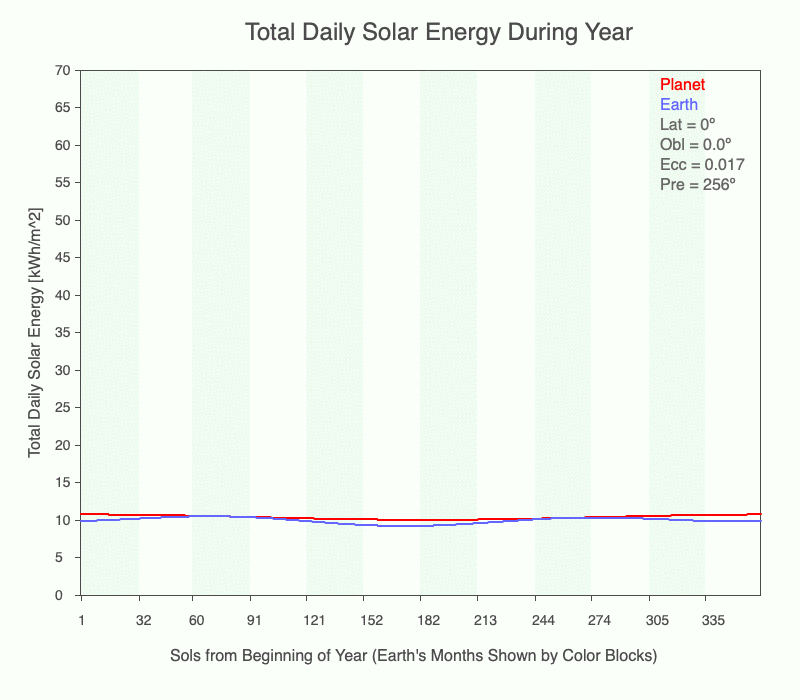
Animation of the equator’s total daily solar energy received throughout the year as the planet’s obliquity increased from 0º to 90º. The equator almost always experiences a constant 12 hours of daylight throughout the year. The only exception is during the solstices when the planet has a 90º obliquity. The sun will be on the horizon for 24 hours that day.
As the obliquity increases, noticeable cold seasons develop on the equator, and they are centered on the solstices. During the equinoxes, the sun will be overhead at local noon.
45ºN
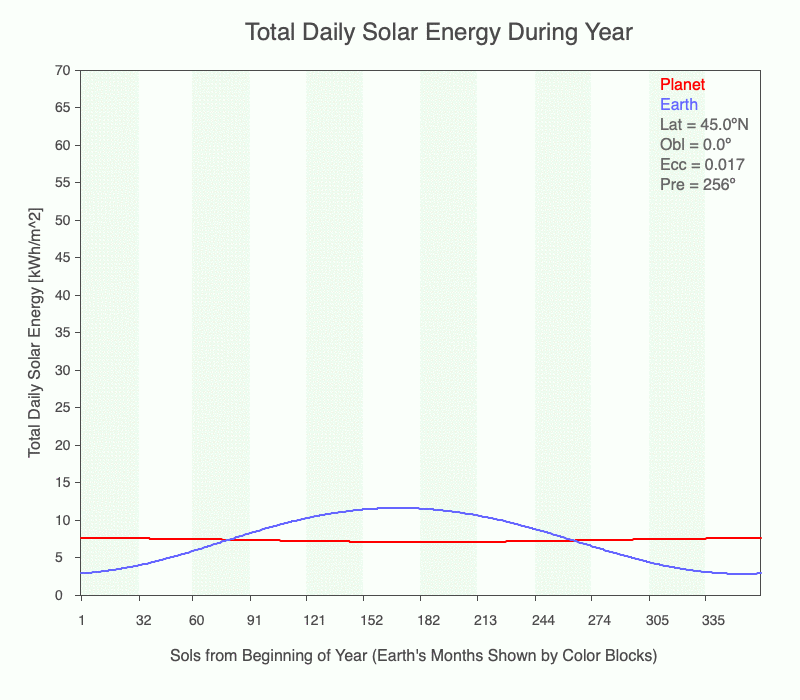
Animation of how the total daily solar energy received at 45ºN throughout the year changes as the planet’s obliquity increased from 0º to 90º.
When the obliquity is 0º, the TDSE is near-constant throughout the year, so there would be no temperature change throughout the year. As obliquity increases, the temperature changes between the summer and winter seasons increases. When the obliquity is 45º or more, the latitude experiences periods of prolonged darkness and periods of intense TDSE. The summers would become much hotter, and the winter months frigidly cold.
North Pole (90ºN)
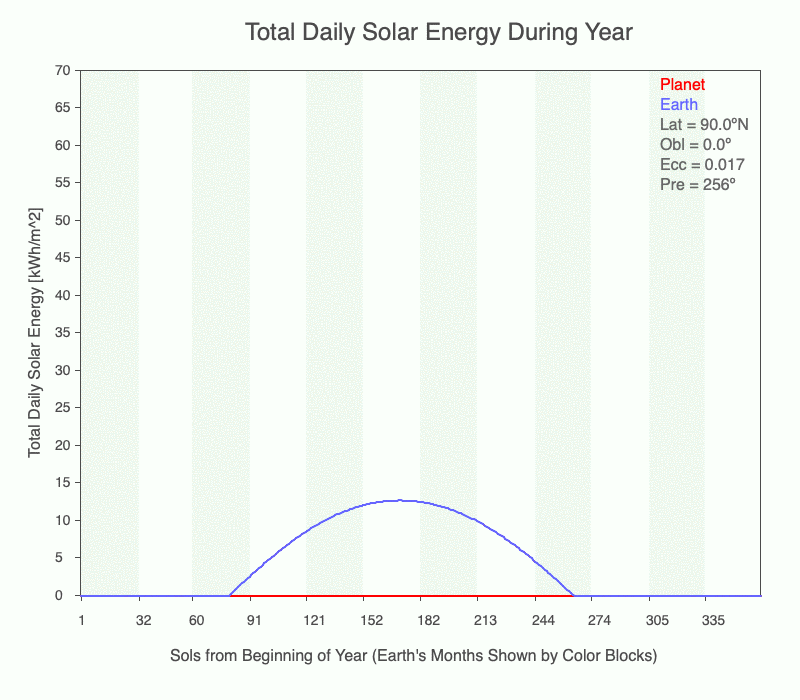
Animation of the North Pole’s total daily solar energy received throughout the year as the planet’s obliquity increased from 0º to 90º. The North Pole almost always experiences six months of daylight and six months of darkness. The only exception is during the solstices when the planet has a 0º obliquity. The sun will remain on the horizon throughout the year.
As the obliquity increases, the North Pole’s summer becomes increasingly hotter. At 90º obliquity, the TDSE during the summer solstice is almost three times that received on Earth. The North Pole would become blisteringly hot during these conditions, only to experience six months of darkness beginning three months later.
Changing Obliquity, Seasons, and Climate Regimes
We estimate the seasonal temperature changes by latitude throughout the year using the annual range of three values: number of daylight hours, local noon sun, and total daily solar energy (TDSE). The animations below show how the variables change as obliquity increases from 0º to 90º in 5-degree increments. TDSE combines the number of daylight hours and the angle of the sun above the horizon throughout the day. For more information on TDSE, see Climate Regimes.
The red line is the planet’s value for the selected latitude and obliquity. Compare the trends to those on Earth (blue line).
Equator (0º)
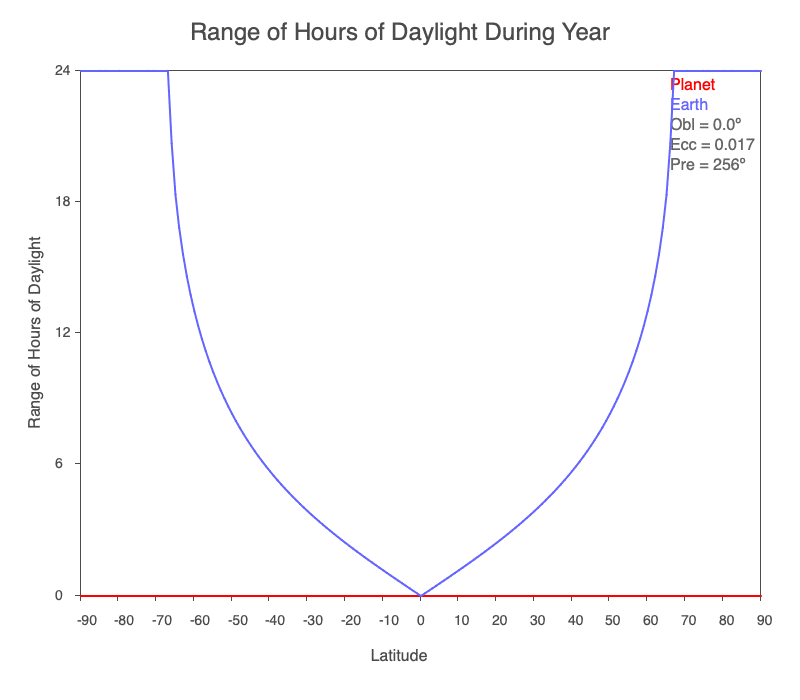
Animation of the annual range of daylight hours by latitude as obliquity increases. When obliquity is 0º, all but the Poles receive 12 hours of daylight each day. At the Poles, the star remains on the horizon throughout the year.
As obliquity increases, more of the higher latitudes experience 24 hours of daylight and also darkness. When the obliquity is 90º, all but the equator experience at least 24 hours of daylight and night throughout the year. At the equator, the star remains on the horizon for 24 hours at the solstices.
45ºN
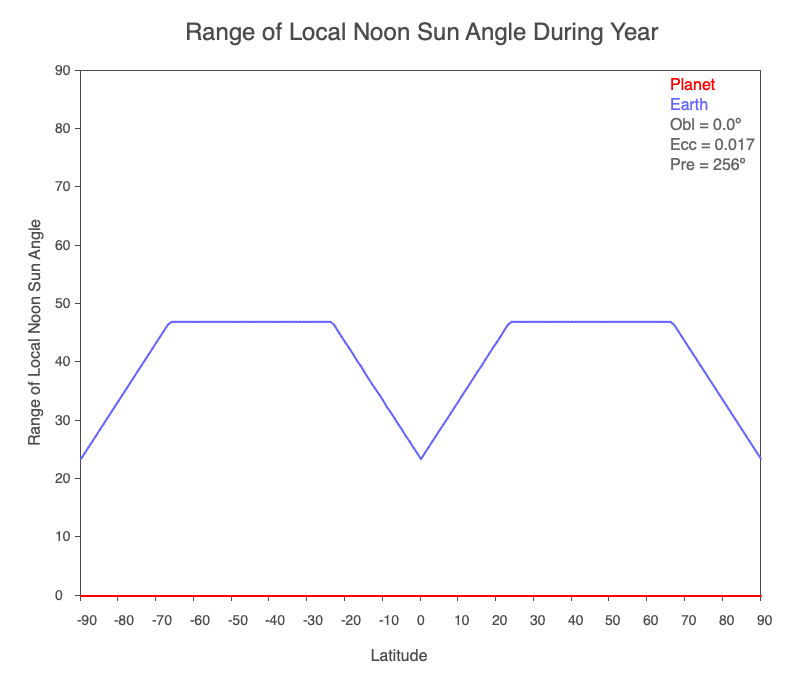
Animation of the annual range of local noon sun angle by latitude as obliquity increases. When obliquity is 0º, the local noon sun angle doesn’t change by latitude. So every day is the same throughout the year at each latitude.
As obliquity increases, more latitudes experience a greater annual range of local noon sun angle. By 90º obliquity, every latitude experiences the local noon sun overhead and on the horizon at some time during the year.
North Pole (90ºN)
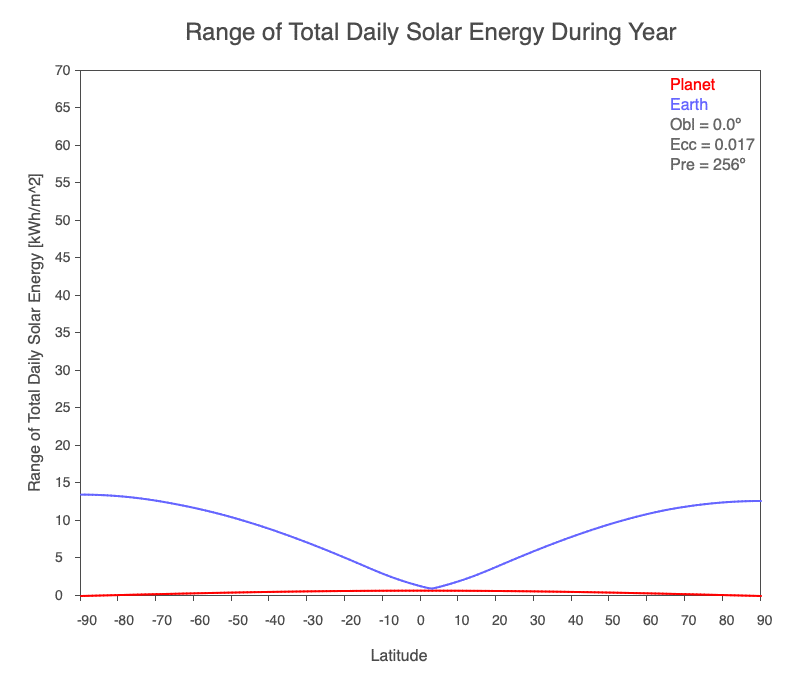
Animation of the annual range of total daily solar energy (TDSE) by latitude as obliquity increases.
When obliquity is 0º, TDSE is constant for a given latitude throughout the year. Every day is the same throughout the year. Recall that the poles experience the star continuously on the horizon, so sunlight never hits the ground. It will remain frigid at the poles throughout the year. The equator always has 12 hours of daylight, and the star is always overhead at local noon. The equator remains consistently hot throughout the year.
As obliquity increases, more latitudes experience a greater annual range of TDSE, especially the higher latitudes. The higher latitudes get warmer and warmer during the summer months, but also become frigid during the extended darkness during the winter months.
Summary
Low obliquity decreases seasonal temperature change with latitude but intensifies the climate difference between latitudes. As obliquity increases, seasonal temperature difference increase at all latitudes, but especially at higher latitudes. Also, climate regimes tend to merge since all latitudes experience cold to frigid winters and hot to deadly hot summers.
Continue Exploring the Impacts of Obliquity on a Planet’s Radiation Budget
Use the desktop app, Star-Planet Connection, to explore the planet’s illumination at any day during its orbit as you change obliquity. Download Mac or PC versions at the Software page.
Big Ideas
- Obliquity is the angle of the planet’s axis of rotation from the perpendicular to the orbital plane.
- The changing positions of the planets alter the gravitational pull between the moving masses in a solar system and change a planet’s obliquity.
- As obliquity changes, the maximum amount of illumination in the northern and southern hemispheres changes, affecting the seasonal temperature patterns.

0 Comments